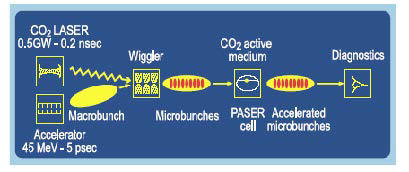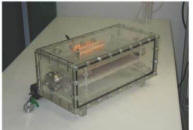- Home
- Capabilities
- Science Highlights
- Operations
- Publications
-
ES&H
- Experiment Start-up
- Laser Safety
Collider-Accelerator Dept.
- C-AD ES&H Resources
- Staff
- Users' Place
- Apply for Access
First Demonstration of Particle Acceleration by Stimulated Emission of Radiation (PASER)
Particle Acceleration by Stimulated Emission of Radiation (PASER) is synergetic to the preceding STELLA experiment provided that it uses the same wiggler for micro-bunching the electron beam. The 70 MeV electron micro-bunches periodical to the CO2 laser wavelength were injected into a discharge cell (below left) containing mixture of gases typically used in a CO2 laser excited by an electrical discharge. A 2 µm diamond window separated a gas filled vessel from a high vacuum electron beam line. The figure below (right) shows a picture of the cell before it’s installation into a beam line.


A principle diagram (left), and an interaction cell (right) of the ATF’s PASER experiment.
The physics underlying PASER’s acceleration scheme are considered as the inverse laser effect. A particle moving within a normally lossy medium or near a metallic structure induces eddy currents. The heat dissipated by these currents comes at the expense of the particle’s kinetic energy. Replacing the lossy medium by an active medium with an inverted population (negative resistance), the secondary field produced by the medium reverses its phase and accelerates the particle. In other words, energy stored in the medium is transferred to the moving particle via such an interaction. The 200 keV energy gain recorded in the ATF experiment was an initial proof-of-principle demonstration of the PASER effect that is under further development now.
Banna, S., V. Berezovsky, and L. Schächter, Experimental Observation of Direct Particle Acceleration by Stimulated Emission of Radiation. Phys Rev Lett, 2006. 97(13): p.134801




